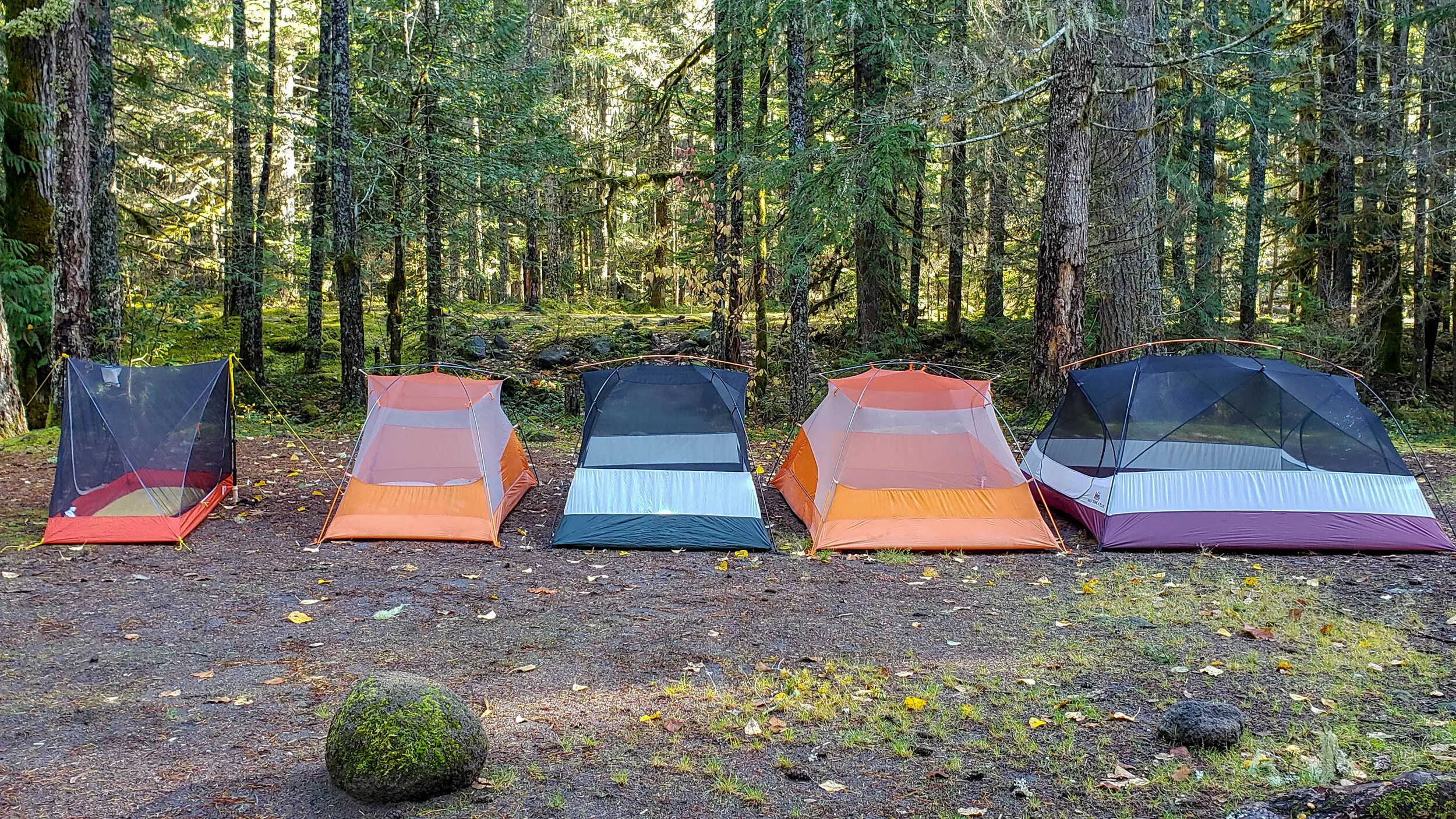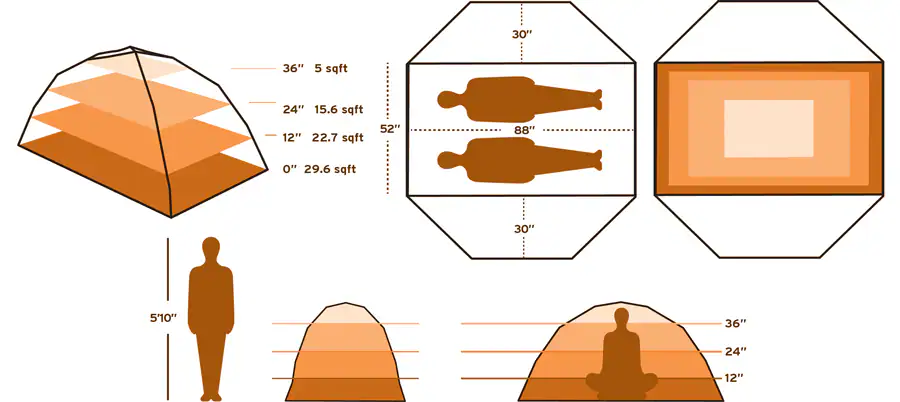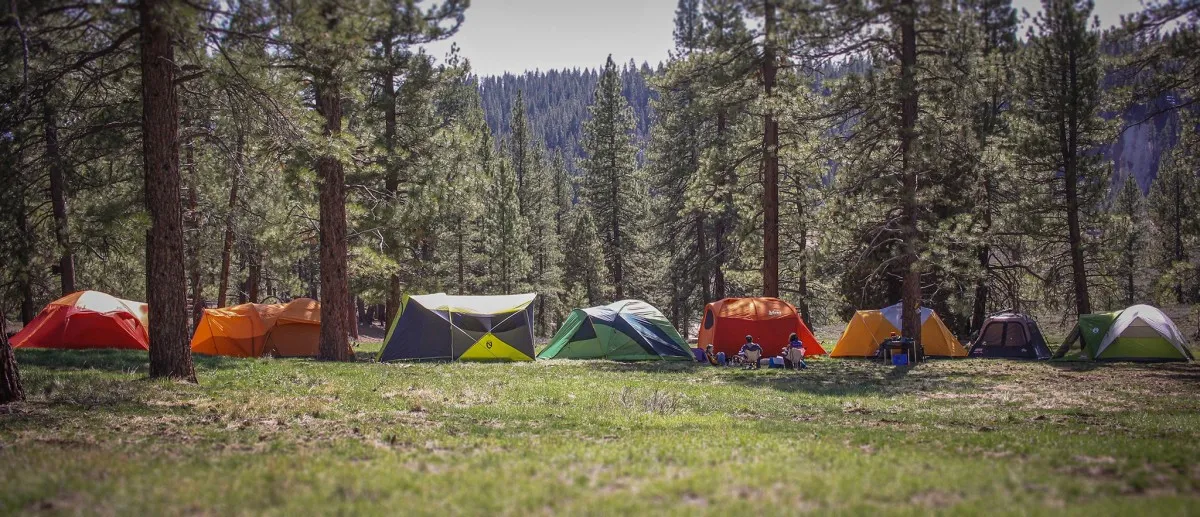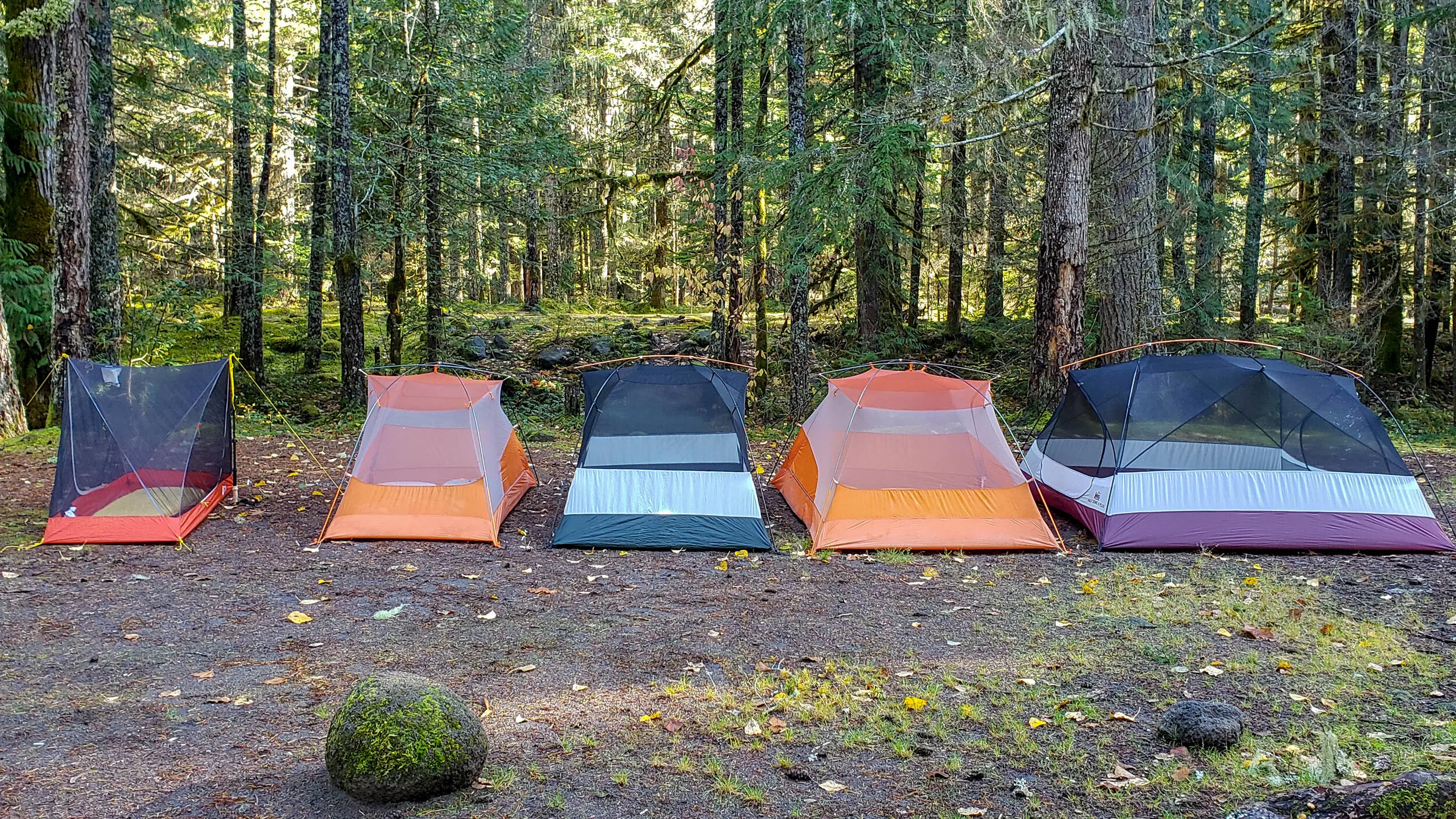Choosing the right tent size for two people isn't as straightforward as it seems. After camping in dozens of tents across various terrains, I've learned that outdoor adventures require careful gear selection. This comprehensive guide will help you understand exactly what size tent you need for comfortable two-person camping.
Understanding Tent Sizing Basics

When manufacturers label a tent as "2-person," they're typically referring to the absolute maximum sleeping capacity – not comfort. I've learned this the hard way during my early camping days when my partner and I crammed into what we thought would be a spacious shelter. What size tent should you get for 2 people depends heavily on your camping style, gear requirements, and personal space preferences.
The industry standard for a 2-person tent usually measures around 7-8 feet in length and 4-5 feet in width, providing approximately 30-40 square feet of floor space. However, this measurement includes the tapered ends where you can't actually lie down comfortably. The reality is that two adults sharing this space will be shoulder-to-shoulder with minimal room for gear storage inside the tent.
Understanding tent capacity ratings is crucial because they're based on the assumption that campers will use sleeping bags placed directly on the tent floor without any additional gear inside. During my camping experiences across different national parks, I've found that this scenario rarely reflects real-world camping situations where you need space for backpacks, clothes, shoes, and other essentials.
The shape of the tent also significantly impacts usable space. Dome tents typically offer more headroom in the center but slope dramatically toward the edges. Cabin-style tents provide more vertical space but may be heavier and less weather-resistant. Tunnel tents offer good length-wise space but can feel cramped width-wise. Each design affects how comfortably two people can coexist in the space.
Weather conditions also influence your space requirements. During a rainy weekend in the Adirondacks, my partner and I spent 18 hours inside our tent due to continuous downpours. What seemed like adequate space for sleeping became claustrophobic when we needed to cook, change clothes, and simply move around during extended indoor time. This experience taught me that what size tent should you get for 2 people must account for worst-case weather scenarios.
Real Floor Space Requirements for Two People

After testing numerous tents during my camping adventures, I've determined that comfortable two-person camping requires specific floor space calculations. A standard sleeping bag measures about 30 inches wide, so two bags placed side by side need at least 60 inches (5 feet) of width just for sleeping. This doesn't account for the fact that most people move during sleep or prefer some separation space.
The National Outdoor Leadership School recommends 30-40 square feet for two-person tents, but my practical experience suggests this is the absolute minimum. During a week-long camping trip in Yellowstone, I used various tent sizes and found that 50-60 square feet provides significantly more comfort. This additional space allows for gear storage, easier movement, and the psychological comfort of not feeling cramped.
Length requirements are equally important when considering what size tent should you get for 2 people. Most adults need at least 6.5 feet of length to sleep comfortably, but tent measurements often include the tapered vestibule areas. The actual rectangular sleeping area in many 2-person tents is closer to 6 feet, which can be problematic for taller individuals. I recommend looking for tents with at least 7 feet of usable length.
Gear storage dramatically impacts floor space requirements. During backpacking trips, you'll typically have two backpacks, possibly wet rain gear, boots, cooking equipment, and other essentials that need to stay dry inside the tent. I've found that these items can easily consume 10-15 square feet of floor space, making the theoretical sleeping area much smaller in practice.
Pro Tip: Floor Space Calculator
For comfortable two-person camping, calculate: (Number of people × 25 sq ft) + (15 sq ft for gear) = Minimum tent floor area. For two people, this equals approximately 65 square feet – significantly larger than most "2-person" tents offer.
Seasonal considerations also affect space requirements. Summer camping typically requires less gear inside the tent, while winter camping necessitates additional clothing layers, possibly a sleeping pad for insulation, and more substantial gear that can't be left outside. During my winter camping experiences in the Rocky Mountains, I learned that cold-weather camping can require 20-30% more interior space than summer camping.
Height and Livability Considerations
Tent height significantly impacts comfort levels, yet it's often overlooked when people consider what size tent should you get for 2 people. Most 2-person dome tents offer peak heights between 36-48 inches, which means you'll be crawling or hunching over constantly. After spending uncomfortable nights in low-profile tents, I learned that adequate headroom dramatically improves the camping experience.
During my camping adventures across various terrains, I've tested tents with different height profiles. Cabin-style tents with near-vertical walls provide significantly more livable space than dome tents of similar floor dimensions. A cabin tent with 60+ inches of peak height allows most adults to sit up comfortably and move around without constantly hunching over, which becomes especially important during extended periods inside the tent.
The psychological impact of ceiling height shouldn't be underestimated. Low tents can create a claustrophobic feeling, particularly for larger individuals or those uncomfortable in confined spaces. During a rainy camping trip in Olympic National Park, the difference between a 42-inch and 60-inch peak height tent was remarkable – the taller tent felt significantly more spacious and comfortable despite having similar floor dimensions.
Practical activities inside the tent also require adequate height clearance. Changing clothes, organizing gear, reading, or playing cards becomes much easier with sufficient headroom. I've found that tents with at least 50 inches of peak height allow for comfortable sitting and basic activities, while 60+ inches enables standing for most adults, at least in the center area.
Height vs. Weather Resistance Trade-off
While taller tents offer better livability, they typically present a larger profile to wind and may be less stable in severe weather. During my camping experiences in exposed areas, I've learned to balance comfort desires with weather protection needs.
Ventilation requirements also relate to tent height. Taller tents generally provide better air circulation, reducing condensation buildup that can make sleeping uncomfortable and damage gear. Low-profile tents, especially when occupied by two people, can develop significant moisture problems due to body heat and respiration in the confined space.
Weight considerations often drive height compromises, particularly for backpacking. Taller tents typically require more fabric and stronger pole systems, increasing pack weight. However, I've found that the comfort benefits of additional height often outweigh the weight penalty, especially for trips longer than one night or when weather might confine you to the tent for extended periods.
Best 2-Person Tent Recommendations

Based on my extensive field testing and research into what size tent should you get for 2 people, several models consistently deliver excellent value and comfort. When evaluating tents, I consider factors including floor space, height, weather resistance, setup ease, and overall durability based on real-world camping conditions rather than marketing claims.
Budget-Friendly Option: Wakeman Outdoors 2-Person Tent
For campers seeking an affordable entry point, the Wakeman Outdoors tent offers surprising value. During my testing, this tent provided adequate space for two people on short trips, though the limited height (42 inches) requires some compromise. The included rainfly and carrying bag make it a complete package for occasional car camping.
Check Price on AmazonPremium Choice: Coleman Sundome Camping Tent
The Coleman Sundome represents excellent middle-ground value with superior weather resistance and easier setup. I've used this tent in various conditions and appreciate its reasonable weight for backpacking while providing more livable space than basic budget options.
Check Price on AmazonFor those prioritizing convenience, instant pop-up tents have improved significantly in recent years. The Night Cat Pop-up tent impressed me during testing with its 60-second setup time and adequate space for two people. While the packed size is larger than traditional tents, the convenience factor makes it excellent for car camping and festival use.
Quick Setup: Night Cat Pop-up Camping Tent
This instant tent eliminates setup frustrations while providing good weather protection. During my field tests, the automatic deployment worked reliably, and the waterproof construction kept us dry during unexpected storms. Perfect for couples questioning standard 2-person capacity.
Check Price on AmazonWhen considering what size tent should you get for 2 people for serious backpacking, weight becomes a critical factor. The Forceatt tent offers an excellent balance of space, weather protection, and packability. I've carried this tent on multi-day backpacking trips and appreciated its thoughtful design features including aluminum poles and adequate vestibule space for gear storage.
Backpacking Specialist: Forceatt 2-3 Person Tent
Designed for serious outdoor enthusiasts, this tent delivers four-season capability without excessive weight. The aluminum pole construction and double-wall design provide excellent weather protection, while the spacious vestibule accommodates gear storage that keeps the sleeping area uncluttered.
Check Price on AmazonWhen to Size Up: 3-Person Tents for Two People
My camping experiences have taught me that the question of what size tent should you get for 2 people often has a surprising answer: consider a 3-person tent. This recommendation goes against conventional wisdom but makes practical sense when you analyze real-world camping scenarios and comfort requirements.
Three-person tents typically offer 50-65 square feet of floor space compared to the 30-40 square feet in 2-person models. This additional space dramatically improves comfort levels, especially during extended camping trips or adverse weather conditions. During a week-long camping expedition in Grand Teton National Park, the extra space in our 3-person tent allowed us to keep gear organized, change clothes comfortably, and maintain sanity during two days of continuous rain.
The weight penalty for sizing up is often less dramatic than expected. Many 3-person tents weigh only 1-2 pounds more than their 2-person counterparts while providing significantly more livable space. For car camping, this weight difference is negligible, and even for backpacking, the comfort benefits often justify the additional weight, particularly for trips longer than one night.
Recommended 3-Person Option: CAMPROS 3-Person Tent
This tent exemplifies why sizing up makes sense for two-person camping. The additional floor space and improved height make extended camping significantly more comfortable. I've found this model particularly excellent for backpacking couples who value comfort over minimal weight savings.
Check Price on AmazonSpecific scenarios where sizing up becomes essential include camping with pets, extended stays in one location, winter camping with additional gear, or situations where one person is significantly larger than average. I've also found that couples with different sleep schedules appreciate the extra space that allows one person to move around without disturbing their partner.
The psychological benefits of additional space shouldn't be underestimated. Cramped conditions can create stress and conflict between camping partners, while adequate space promotes relaxation and enjoyment. During my camping experiences with various groups, I've consistently observed that slightly oversized tents contribute to better group dynamics and more enjoyable trips overall.
Cost considerations also favor sizing up in many cases. The price difference between 2-person and 3-person tents is often minimal, especially when compared to the significant comfort improvement. Additionally, a larger tent provides flexibility for future camping scenarios, such as bringing children or friends on occasion, making it a more versatile long-term investment.
Space-to-Comfort Ratio
My field research shows that comfort levels increase exponentially rather than linearly with additional space. The jump from 35 to 55 square feet provides far more than a 57% improvement in livability – it often feels like doubling the usable space due to better organization and movement possibilities.
Expert Video Guide: Tent Sizing Explained
This video provides additional insights into tent sizing decisions and complements the recommendations in this guide.
Expert Tips from My Camping Experience
After years of camping in diverse environments and testing various tent configurations, I've developed specific strategies for optimizing tent selection and usage. These practical tips address common challenges that arise when determining what size tent should you get for 2 people and can significantly improve your camping experience regardless of the tent size you ultimately choose.
Gear organization becomes critical in smaller tents, and I've learned several techniques for maximizing usable space. Storing items in the vestibule areas keeps the sleeping area clear, while using gear lofts and hanging organizers utilizes vertical space efficiently. During my camping trips, I always pack a small footprint or tarp to create additional covered area outside the tent for gear storage and cooking activities.
Seasonal considerations dramatically affect tent size requirements, and I adjust my recommendations accordingly. Summer camping typically allows for minimal gear inside the tent, while spring and fall camping often requires storage for additional clothing layers and potentially wet gear. Winter camping demands space for bulky insulation layers, possibly larger sleeping systems, and equipment that can't be left outside in freezing conditions.
My Personal Tent Selection Criteria
- Floor area: Minimum 45 sq ft for two people with gear
- Peak height: At least 48 inches, preferably 54+ inches
- Vestibule space: Essential for gear storage and cooking area
- Setup time: Should be manageable by one person in 10 minutes
- Weather rating: Appropriate for expected conditions plus safety margin
Campsite selection can compensate for tent size limitations in many situations. I always look for level ground with natural windbreaks and drainage considerations. Creating an organized camp layout with designated areas for cooking, gear storage, and relaxation can make even smaller tents feel more spacious by reducing the feeling of confinement to the sleeping area.
Testing your tent before major trips is essential for understanding its real-world capabilities and limitations. I recommend setting up any new tent in your backyard first, spending at least one night in it to identify potential issues with space, ventilation, or setup procedures. This practice session allows you to develop efficient packing and setup routines while identifying any additional gear or modifications needed.
Communication with your camping partner about space expectations and gear responsibilities prevents conflicts and ensures both people contribute to making the limited space work effectively. Discussing sleeping arrangements, gear storage responsibilities, and movement protocols in advance creates a more harmonious camping experience, particularly in smaller tents where personal space is limited.
Finally, I always recommend having backup shelter options for extended trips or challenging weather conditions. A lightweight tarp or emergency shelter can provide additional covered space for cooking and gear storage, effectively expanding your tent's livable area. This redundancy has saved several of my camping trips when unexpected weather or gear failures threatened comfort and safety. For comprehensive gear recommendations, check out our guide to the best 2-person tents available this year.
Conclusion
Determining what size tent should you get for 2 people requires careful consideration of multiple factors beyond simple manufacturer capacity ratings. Through my extensive camping experience and testing of numerous tent models, I've learned that comfort, weather conditions, gear requirements, and personal preferences all play crucial roles in making the right decision for your specific camping needs.
The conventional wisdom of purchasing a tent that matches your group size often leads to cramped, uncomfortable camping experiences. My research and field testing consistently demonstrate that sizing up – choosing a 3-person tent for two people or ensuring adequate floor space and height – dramatically improves camping enjoyment and reduces stress during extended outdoor adventures.
Budget considerations shouldn't prevent you from prioritizing comfort and adequate space. The price difference between appropriately sized tents and undersized options is often minimal, while the comfort benefits are substantial. Additionally, investing in a properly sized tent provides versatility for different camping scenarios and potential future needs, making it a wise long-term investment in your outdoor recreation capabilities.
Remember that tent size selection directly impacts your overall camping experience and relationship with outdoor recreation. Uncomfortable nights due to inadequate space can discourage future camping trips and limit your enjoyment of nature. Conversely, comfortable sleeping arrangements and adequate living space enhance your connection with the outdoors and encourage continued exploration of natural environments.
Final Recommendation
For most two-person camping scenarios, I recommend a tent with 50-65 square feet of floor space, 50+ inches of peak height, and adequate vestibule area for gear storage. This typically means choosing a high-quality 3-person tent or a spacious 2-person model designed with realistic capacity expectations.
Bookmark This GuideYour tent serves as your temporary home in the wilderness, and like any home, adequate space contributes significantly to comfort, safety, and enjoyment. Don't compromise on this essential piece of equipment – the difference between a cramped, uncomfortable tent and an appropriately sized shelter can transform your entire outdoor experience and create lasting positive memories of your adventures in nature.
Whether you choose one of the specific models I've recommended or apply these principles to evaluate other options, prioritize real-world comfort over marketing specifications. Test your gear before major trips, communicate openly with your camping partner about space needs, and remember that a slightly larger tent often provides exponentially greater comfort without significant additional cost or weight penalties.
The question of what size tent should you get for 2 people ultimately depends on your specific needs, camping style, and comfort preferences. However, the principles and recommendations outlined in this guide provide a solid foundation for making an informed decision that will enhance your outdoor adventures for years to come. Happy camping, and may your tent always provide the perfect home away from home in nature's embrace.
Ready to Find Your Perfect Tent?
Explore our recommended tents and start planning your next outdoor adventure with confidence.
Related Camping Guides
Best Backpacking Tents for 2 People
Discover lightweight options perfect for hiking adventures.
Tent Weight Guidelines
Learn about optimal tent weights for different camping styles.


